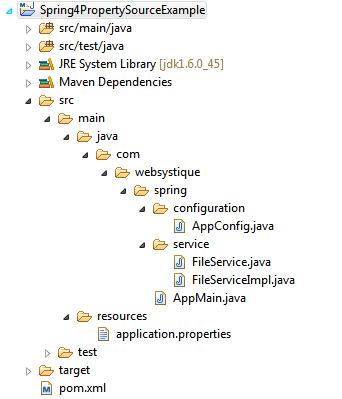【译】Spring 4 @PropertySource和@Value注解示例
前言
译文链接:http://websystique.com/spring/spring-propertysource-value-annotations-example/
本篇文章将展示如何通过@PropertySource 和 @Value注解从配置文件中读取属性值。
同样,我们也会讨论Spring的Environment接口,还会看到使用XML配置和使用注解的对比。
Spring的@PropertySource注解主要是让Spring的Environment接口读取属性配置文件用的,这个注解是标识在@Configuration配置类上的。
Spring的@Value注解可以用在字段和方法上。通常用于从属性配置文件中读取属性值,也可以设置默认值。接下来就让我么看下完整的例子吧。
涉及的技术及开发工具
- Spring 4.0.6.RELEASE
- Maven 3
- JDK 1.6
- Eclipse JUNO Service Release 2
工程结构目录

步骤一:往pom.xml中添加依赖
<project xmlns="http://maven.apache.org/POM/4.0.0" xmlns:xsi="http://www.w3.org/2001/XMLSchema-instance"
xsi:schemaLocation="http://maven.apache.org/POM/4.0.0 http://maven.apache.org/xsd/maven-4.0.0.xsd">
<modelVersion>4.0.0</modelVersion> <groupId>com.websystique.spring</groupId>
<artifactId>Spring4PropertySourceExample</artifactId>
<version>1.0.0</version>
<packaging>jar</packaging> <name>Spring4PropertySourceExample</name> <properties>
<springframework.version>4.0.6.RELEASE</springframework.version>
</properties> <dependencies>
<dependency>
<groupId>org.springframework</groupId>
<artifactId>spring-core</artifactId>
<version>${springframework.version}</version>
</dependency>
<dependency>
<groupId>org.springframework</groupId>
<artifactId>spring-context</artifactId>
<version>${springframework.version}</version>
</dependency>
</dependencies>
<build>
<pluginManagement>
<plugins>
<plugin>
<groupId>org.apache.maven.plugins</groupId>
<artifactId>maven-compiler-plugin</artifactId>
<version>3.2</version>
<configuration>
<source>1.6</source>
<target>1.6</target>
</configuration>
</plugin>
</plugins>
</pluginManagement>
</build> </project>
步骤二:创建Spring配置类
Spring配置类是指用@Configuration注解标注的类,这些类包含了用@Bean标注的方法。这些被@Bean标注的方法可以生产bean并交由spring容器管理。
package com.websystique.spring.configuration; import org.springframework.context.annotation.Bean;
import org.springframework.context.annotation.ComponentScan;
import org.springframework.context.annotation.Configuration;
import org.springframework.context.annotation.PropertySource;
import org.springframework.context.support.PropertySourcesPlaceholderConfigurer; @Configuration
@ComponentScan(basePackages = "com.websystique.spring")
@PropertySource(value = { "classpath:application.properties" })
public class AppConfig { /*
* PropertySourcesPlaceHolderConfigurer Bean only required for @Value("{}") annotations.
* Remove this bean if you are not using @Value annotations for injecting properties.
*/
@Bean
public static PropertySourcesPlaceholderConfigurer propertySourcesPlaceholderConfigurer() {
return new PropertySourcesPlaceholderConfigurer();
}
}
@PropertySource(value = { “classpath:application.properties” })注解可以让在application.properties文件中定义的属性对Spring Envirronment bean可用,Environment接口提供了getter方法读取单独的属性值。
注意PropertySourcesPlaceholderConfigurer这个bean,这个bean主要用于解决@value中使用的${…}占位符。假如你不使用${…}占位符的话,可以不使用这个bean。
以上的配置使用XML替代的话,如下:
app-config.xml
<?xml version="1.0" encoding="UTF-8"?>
<beans xmlns="http://www.springframework.org/schema/beans"
xmlns:xsi="http://www.w3.org/2001/XMLSchema-instance"
xmlns:context="http://www.springframework.org/schema/context"
xsi:schemaLocation="http://www.springframework.org/schema/beans http://www.springframework.org/schema/beans/spring-beans-4.0.xsd
http://www.springframework.org/schema/context http://www.springframework.org/schema/context/spring-context-4.0.xsd"> <context:component-scan base-package="com.websystique.spring"/> <bean class="org.springframework.context.support.PropertySourcesPlaceholderConfigurer">
<property name="ignoreUnresolvablePlaceholders" value="true"/>
<property name="locations">
<list>
<value>classpath:application.properties</value>
</list>
</property>
</bean>
</beans>
步骤三:创建配置文件
jdbc.driverClassName = com.mysql.jdbc.Driver
jdbc.url = jdbc:mysql://localhost:3306/websystique
jdbc.username = myuser
jdbc.password = mypassword
hibernate.dialect = org.hibernate.dialect.MySQLDialect
hibernate.show_sql = false
hibernate.format_sql = false
sourceLocation = /dev/input
我们将会在service类里使用上面提到的配置方式读取这个配置文件
步骤四:创建服务类
package com.websystique.spring.service;
public interface FileService {
void readValues();
}
package com.websystique.spring.service; import org.springframework.beans.factory.annotation.Autowired;
import org.springframework.beans.factory.annotation.Value;
import org.springframework.core.env.Environment;
import org.springframework.stereotype.Service; @Service("fileService")
public class FileServiceImpl implements FileService { @Value("${sourceLocation:c:/temp/input}")
private String source; @Value("${destinationLocation:c:/temp/output}")
private String destination; @Autowired
private Environment environment; public void readValues() {
System.out.println("Getting property via Spring Environment :"
+ environment.getProperty("jdbc.driverClassName")); System.out.println("Source Location : " + source);
System.out.println("Destination Location : " + destination); } }
这里首先要注意的是Environment bean被Spring自动注入。另外,由于配置了@PropertySoruce注解,Environment bean可以访问指定配置文件里定义的所有属性值。你可以使用getProperty方法得到指定值。
另外一点值得注意的是@Value注解,基本格式如下:
@value("${key:default")
private String var;
以上声明指导spring根据key去属性配置文件查找value,如果没找到,则使用default作为默认值。
注意以上的${…}占位符只有当注册了PropertySourcesPlaceholderConfigurer bean后才能被解析,否则@Value注解会一直将默认值赋值给var。
步骤五:创建Main方法运行程序
package com.websystique.spring; import org.springframework.context.annotation.AnnotationConfigApplicationContext;
import org.springframework.context.support.AbstractApplicationContext; import com.websystique.spring.configuration.AppConfig;
import com.websystique.spring.service.FileService; public class AppMain { public static void main(String args[]){
AbstractApplicationContext context = new AnnotationConfigApplicationContext(AppConfig.class);
FileService service = (FileService) context.getBean("fileService"); service.readValues();
context.close();
} }
运行以上程序,得到如下结果:
Getting property via Spring Environment :com.mysql.jdbc.Driver
Source Location : /dev/input
Destination Location : c:/temp/output
AbstractApplicationContext context = new AnnotationConfigApplicationContext(AppConfig.class);AbstractApplicationContext context = new ClassPathXmlApplicationContext("app-config.xml");工程源码
http://websystique.com/?smd_process_download=1&download_id=796
【译】Spring 4 @PropertySource和@Value注解示例的更多相关文章
- Spring学习(三)——@PropertySource,@ImportResource,@Bean注解
@PropertySource注解是将配置文件中 的值赋值给POJO 项目结构如下 一.创建一个Person.Java文件: import org.springframework.boot.conte ...
- [译]Spring构建微服务
此文为译文,原文地址 介绍 本文通过一个使用Spring.Spring Boot和Spring Cloud的小例子来说明如何构建微服务系统. 我们可以通过数个微服务组合成一个大型系统. 我们可以想象下 ...
- 深入学习Spring框架(二)- 注解配置
1.为什么要学习Spring的注解配置? 基于注解配置的方式也已经逐渐代替xml.所以我们必须要掌握使用注解的方式配置Spring. 关于实际的开发中到底使用xml还是注解,每家公司有着不同的使用习惯 ...
- 循序渐进之Spring AOP(6) - 使用@Aspect注解
前面几节的示例看起来让人沮丧,要记忆如此多的接口.类和继承关系,做各种复杂的配置.好在这些只是一种相对过时的实现方式,现在只需要使用@Aspect注解及表达式就可以轻松的使用POJO来定义切面,设计精 ...
- Spring的bean管理(注解)
前端时间总是用配置文件 内容太多 下面认识一下注解 注解是什么? 1代码里面的特殊标记,使用注解可以完成功能 2注解写法@XXX 3使用注解可以少些很多配置文件 Spring注解开发准备 注解创建准 ...
- J2EE进阶(十三)Spring MVC常用的那些注解
Spring MVC常用的那些注解 前言 Spring从2.5版本开始在编程中引入注解,用户可以使用@RequestMapping, @RequestParam,@ModelAttribute等等这样 ...
- Spring和SpringMVC的常用注解
Spring的部分: 使用注解之前要开启自动扫描功能 其中base-package为需要扫描的包(含子包). <context:component-scan base-package=" ...
- (转)Spring的bean管理(注解方式)
http://blog.csdn.net/yerenyuan_pku/article/details/69663779 Spring的bean管理(注解方式) 注解:代码中的特殊标记,注解可以使用在类 ...
- Spring自动装配----注解装配----Spring自带的@Autowired注解
Spring自动装配----注解装配----Spring自带的@Autowired注解 父类 package cn.ychx; public interface Person { public voi ...
随机推荐
- Java 开发主流 IDE 环境体验
前言 本来应该继续从 Oracle 官网搬砖的,但是随着示例代码越来越复杂,涉及的类库越来越多,使用 Vim 写 Java 代码就很力不从心了,是时候上 IDE 了.我最熟悉的 IDE 环境是 Ecl ...
- 转职成为TypeScript程序员的参考手册
写在前面 作者并没有任何可以作为背书的履历来证明自己写作这份手册的分量. 其内容大都来自于TypeScript官方资料或者搜索引擎获得,期间掺杂少量作者的私见,并会标明. 大部分内容来自于http:/ ...
- 使用R画地图数据
用R画地图数据 首先,从这里下载中国地图的GIS数据,这是一个压缩包,完全解压后包含三个文件(bou2_4p.dbf.bou2_4p.shp和bou2_4p.shx),将这三个文件解压到同一个目录下. ...
- MySql LIKE 查找带反斜线“\”的记录
解决方法是在反斜线“\前加“\\\”三个反斜杠. SELECT * FROM 表名 AS a WHERE a.字段 \\\\qc0npwqe.3v4', '%') 原理: 写成三个'\'的原因是反斜线 ...
- MyEclipse 的 配置文件
D:\soft\i\myeclipse10\MyEclipse 10\configuration.settings\org.eclipse.ui.ide.prefs MAX_RECENT_WORKSP ...
- UML类图与面向对象设计原则
1. 引言 从大一开始学习编程,到如今也已经有两年了.从最初学习的Html,Js,JaveSe,再到JavaEE,Android,自己也能写一些玩具.学习过程中也无意识的了解了一些所谓的设计模 ...
- c 数组与指针的使用注意事项
数组变量和指针变量有一点小小的区别 所以把数组指针赋值给指针变量的时候千万要小心 加入把数组赋值给指针变量,指针变量只会包含数组的地址信息 而对数组的长度一无所知 相当于指针丢失了一部分信息,我们把这 ...
- JQuery中ajax的相关方法总结
前提条件 话说是jquery中的ajax方法,那么前提条件当然是引入jquery啦. <script src="http://libs.baidu.com/jquery/1.9.0/j ...
- 2.JAVA之GUI编程布局
布局管理器 容器中的组件排放方式,就是布局 常见的布局管理器: **************************************************** 1.FlowLayout(流式 ...
- MyCat源码分析系列之——SQL下发
更多MyCat源码分析,请戳MyCat源码分析系列 SQL下发 SQL下发指的是MyCat将解析并改造完成的SQL语句依次发送至相应的MySQL节点(datanode)的过程,该执行过程由NonBlo ...
